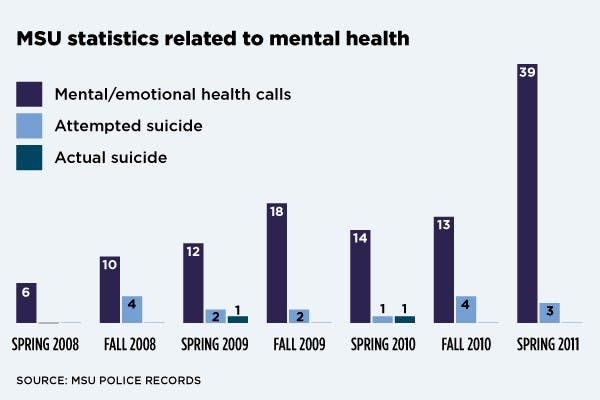Editor’s note: The name of the student in the beginning of this story has been changed to protect anonymity.
Sitting in her parents’ furnace room with a rifle propped between her legs, Natasha Jones wanted an end to the beatings from her father, the pressure from her mother to be thin and the constant bullying at school.
She wanted to die.
“I literally thought my parents hated me,” said Jones, whose name has been changed to protect her identity.
“My dad would hit me, and my mom would tell me I deserved it. Obviously they don’t care if I got hurt. Maybe, I thought (killing myself) was punishment to them.”
Jones was able to walk away from the rifle that night.
She’s one of the 5.7 percent of adults ages 18-29 who have contemplated suicide, according to 2008-09 statistics from the Centers for Disease Control and Prevention.
Pushed to their breaking point by the demands of college life, substance abuse and underlying mental illnesses, among other things, each year about 1,100 American college students commit suicide, Juliette Niemi, the Counseling Center educational program director said.
And almost every year since 2008, an MSU student does too, according to statistics from MSU Police.
Although the numbers of student suicides and suicide attempts at MSU have remained constant in recent years, student activists and counselors are hopeful suicide-prevention methods on campus will help.
Members of Active Minds, a student mental health advocacy group, are working with the MSU Counseling Center to promote mental health among students through free depression screenings and awareness events.
Psychology senior James Dodge, who has struggled with mental illness himself, is the co-president of Active Minds hoping to change the stigma surrounding suicide to help prevent suicides.
“It’s hard to talk about those things even with people you trust,” Dodge said.
“(But) every suicide is a death that is preventable.”
The downward spiral
For Dodge, the coming of winter means another potential struggle with symptoms of depression.
Dodge has not been formally diagnosed with seasonal affective disorder — an illness that gives patients symptoms of depression when sunlight lessens — but he struggled going out and being with friends freshman year because of his thoughts.
Every weekend, he would force himself out of bed to drink and party with his roommates. He tried to self-medicate with alcohol, but the more he drank, the more his depression slipped out of control.
Suicide attempts or suicidal thoughts often are coupled with alcohol or other substance abuse among college students, Niemi said.
Alcohol is used as a tool to escape their struggles with mental health or stress but can exaggerate feelings of anxiety or depression and potentially lead students to suicide, Niemi said.
About half of students treated for attempted suicides at Lansing’s Sparrow Hospital also had alcohol in their system at the time, said John Baker, staff psychiatrist and MSU associate clinical professor of psychiatry.
Support student media!
Please consider donating to The State News and help fund the future of journalism.
Alcohol disables rational thought and sometimes influences students to attempt suicide even if they wouldn’t if they were sober, he said.
Eventually, Dodge’s feelings of loneliness and his random bursts of anger led to fantasies about death.
But at the thought of how his family would react, Dodge was pulled back to reality.
He never attempted suicide.
Of the college-age adults who contemplate suicide, most do not take the next steps to kill themselves, Baker said.
Still, MSU Police recorded five attempted suicides on campus in 2010, and three were reported in spring of this year.
Looking back, Dodge barely can remember the problems that exacerbated his depression.
He does remember the pain he went through and how asking for help could have solved the problems that seemed so overwhelming.
“I wish I had reached out and talked to somebody,” Dodge said. “The road I went down was much longer and more difficult than it had to be.”
A reason to live
As Jones stared down the barrel of her rifle years ago, prepared for the moment the bullet would enter her skull, her phone rang.
A girl from her high school called — the gesture Jones was hoping for.
The sound of a friend’s voice was enough to give her the motivation to live.
Now, as she drives through campus on her moped and cheers in the crowd during football games, she remembers the phone call that saved her life.
“If it weren’t for my friend calling me, I wouldn’t have any of this,” Jones said.
Suicidal students, or students with suicidal thoughts, don’t always seek help because they feel ashamed or are afraid of how people will react, Niemi said.
But resources, such as the Counseling Center and Olin Health Center, offer confidential support for students struggling with thoughts of suicide.
Jones hasn’t told her parents about the night she almost pulled the trigger years ago and has only told two of her closest friends.
She feels embarrassed that at one point she lost the will to live. She wants to be known as a strong person.
But looking back, Jones said her suicidal thoughts weren’t about her weakness.
In the end, choosing to be successful in life for herself shows her inner strength.
“It was just that I didn’t know how to deal with everything,” Jones said. “I had to … find that strong person.”
Discussion
Share and discuss “A will to live” on social media.


